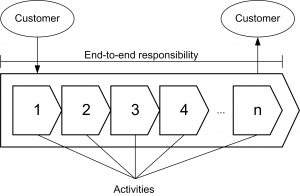Business processes aren’t new phenomena. The term process (e.g. production process) has long been common place in many sectors of the economy. Processes have been an integral part of all firms (Armistead and Rowland, 1996). There is no doubt that there are always processes in an organization, whether they are articulated or not (Karlöf and Lövingsson, 2005). For the term business process, several definitions exist:
- The most known definition of a business process comes from Hammer and Champy (1993): They define a business process as “a collection of activities that takes one or more kinds of input and creates an output that is of value to the customer.”
- The definition of Davenport and Short (1990) is also well known. They state that business processes have two important characteristics: First, they have customers who are the recipients of the process’ defined outcomes. Second, business processes normally aren’t just found inside a functional unit, but cross organizational boundaries and occur across or between functional units.
- A business process is a sequence of steps which transforms inputs into outputs: It is customer focused, i.e. is activated by market and (external or internal) customer needs, value adding, i.e. creates value which is appreciated by the customer, and has a process owner who has end-to-end responsibility for the whole process. Furthermore it has access to all necessary resources and information (Schantin, 2004).

The main characteristics of a business process: customer orientation and end-to-end responsibility, derived from Schantin (2004)